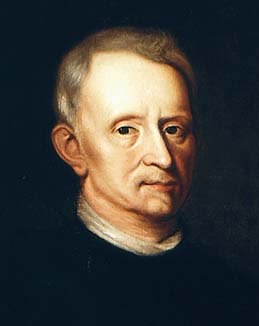
Jan Baptist van Helmont
Jan Baptist van Helmont (/ˈhɛlmɒnt/;[2] Dutch: [ˈɦɛlmɔnt]; 12 January 1580 – 30 December 1644) was a chemist, physiologist, and physician from Brussels. He worked during the years just after Paracelsus and the rise of iatrochemistry, and is sometimes considered to be "the founder of pneumatic chemistry".[3] Van Helmont is remembered today largely for his 5-year willow tree experiment, his introduction of the word "gas" (from the Greek word chaos) into the vocabulary of science, and his ideas on spontaneous generation.
Jan Baptist van Helmont
12 January 1580[a]
30 December 1644 (aged 64)
His name is also found rendered as Jan-Baptiste van Helmont, Johannes Baptista van Helmont, Johann Baptista von Helmont, Joan Baptista van Helmont, and other minor variants switching between von and van.
Early life and education[edit]
Jan Baptist van Helmont was the youngest of five children of Maria (van) Stassaert and Christiaen van Helmont, a public prosecutor and Brussels council member, who had married in the Sint-Goedele church in 1567.[4] He was educated at Leuven, and after ranging restlessly from one science to another and finding satisfaction in none, turned to medicine. He interrupted his studies, and for a few years he traveled through Switzerland, Italy, France, Germany, and England.[5]
Returning to his own country, van Helmont obtained a medical degree in 1599.[6] He practiced at Antwerp at the time of the great plague in 1605, after which he wrote a book titled De Peste[7] (On Plague), which was reviewed by Newton in 1667.[8] In 1609 he finally obtained his doctoral degree in medicine. The same year he married Margaret van Ranst, who was of a wealthy noble family. Van Helmont and Margaret lived in Vilvoorde, near Brussels, and had six or seven children.[4] The inheritance of his wife enabled him to retire early from his medical practice and occupy himself with chemical experiments until his death on 30 December 1644.
Disputed portrait[edit]
In 2003, the historian Lisa Jardine proposed that a portrait held in the collections of the Natural History Museum, London, traditionally identified as John Ray, might represent Robert Hooke.[25] Jardine's hypothesis was subsequently disproved by William B. Jensen of the University of Cincinnati[26] and by the German researcher Andreas Pechtl of Johannes Gutenberg University of Mainz, who showed that the portrait in fact depicts van Helmont.
Honours[edit]
In 1875, he was honoured by Belgian botanist Alfred Cogniaux (1841–1916), who named a genus of flowering plants from South America, Helmontia (from the Cucurbitaceae family).[27]